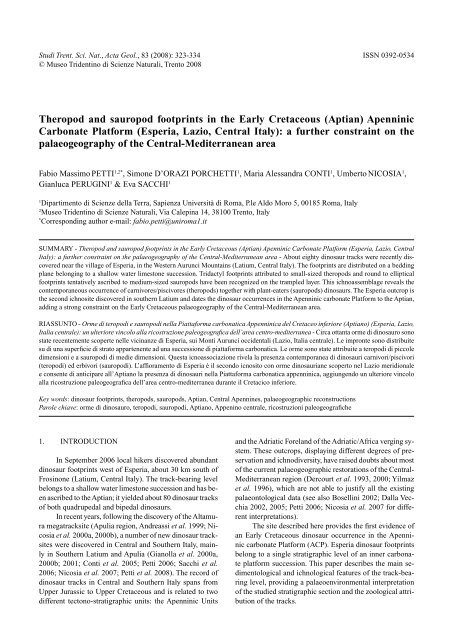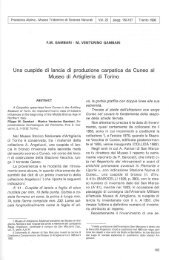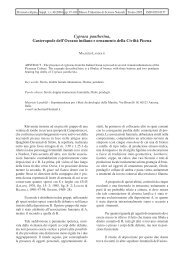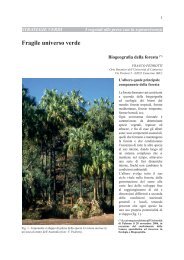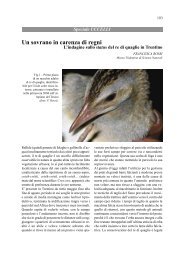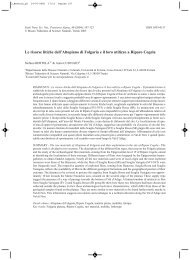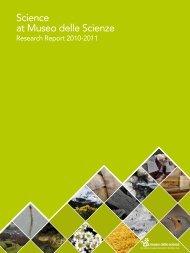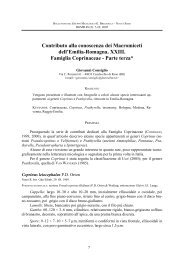scarica pdf 859KB - Museo Tridentino di Scienze Naturali
scarica pdf 859KB - Museo Tridentino di Scienze Naturali
scarica pdf 859KB - Museo Tridentino di Scienze Naturali
You also want an ePaper? Increase the reach of your titles
YUMPU automatically turns print PDFs into web optimized ePapers that Google loves.
Stu<strong>di</strong> Trent. Sci. Nat., Acta Geol., 83 (2008): 323-334 ISSN 0392-0534<br />
© <strong>Museo</strong> <strong>Tridentino</strong> <strong>di</strong> <strong>Scienze</strong> <strong>Naturali</strong>, Trento 2008<br />
Theropod and sauropod footprints in the Early Cretaceous (Aptian) Apenninic<br />
Carbonate Platform (Esperia, Lazio, Central Italy): a further constraint on the<br />
palaeogeography of the Central-Me<strong>di</strong>terranean area<br />
Fabio Massimo PETTI 1,2* , Simone D’ORAZI PORCHETTI 1 , Maria Alessandra CONTI 1 , Umberto NICOSIA 1 ,<br />
Gianluca PERUGINI 1 & Eva SACCHI 1<br />
1 Dipartimento <strong>di</strong> <strong>Scienze</strong> della Terra, Sapienza Università <strong>di</strong> Roma, P.le Aldo Moro 5, 00185 Roma, Italy<br />
2 <strong>Museo</strong> <strong>Tridentino</strong> <strong>di</strong> <strong>Scienze</strong> <strong>Naturali</strong>, Via Calepina 14, 38100 Trento, Italy<br />
* Correspon<strong>di</strong>ng author e-mail: fabio.petti@uniroma1.it<br />
SUMMARY - Theropod and sauropod footprints in the Early Cretaceous (Aptian) Apenninic Carbonate Platform (Esperia, Lazio, Central<br />
Italy): a further constraint on the palaeogeography of the Central-Me<strong>di</strong>terranean area - About eighty <strong>di</strong>nosaur tracks were recently <strong>di</strong>scovered<br />
near the village of Esperia, in the Western Aurunci Mountains (Latium, Central Italy). The footprints are <strong>di</strong>stributed on a bed<strong>di</strong>ng<br />
plane belonging to a shallow water limestone succession. Tridactyl footprints attributed to small-sized theropods and round to elliptical<br />
footprints tentatively ascribed to me<strong>di</strong>um-sized sauropods have been recognized on the trampled layer. This ichnoassemblage reveals the<br />
contemporaneous occurrence of carnivores/piscivores (theropods) together with plant-eaters (sauropods) <strong>di</strong>nosaurs. The Esperia outcrop is<br />
the second ichnosite <strong>di</strong>scovered in southern Latium and dates the <strong>di</strong>nosaur occurrences in the Apenninic carbonate Platform to the Aptian,<br />
ad<strong>di</strong>ng a strong constraint on the Early Cretaceous palaeogeography of the Central-Me<strong>di</strong>terranean area.<br />
RIASSUNTO - Orme <strong>di</strong> teropo<strong>di</strong> e sauropo<strong>di</strong> nella Piattaforma carbonatica Appenninica del Cretaceo inferiore (Aptiano) (Esperia, Lazio,<br />
Italia centrale): un ulteriore vincolo alla ricostruzione paleogeografica dell’area centro-me<strong>di</strong>terranea - Circa ottanta orme <strong>di</strong> <strong>di</strong>nosauro sono<br />
state recentemente scoperte nelle vicinanze <strong>di</strong> Esperia, sui Monti Aurunci occidentali (Lazio, Italia centrale). Le impronte sono <strong>di</strong>stribuite<br />
su <strong>di</strong> una superficie <strong>di</strong> strato appartenente ad una successione <strong>di</strong> piattaforma carbonatica. Le orme sono state attribuite a teropo<strong>di</strong> <strong>di</strong> piccole<br />
<strong>di</strong>mensioni e a sauropo<strong>di</strong> <strong>di</strong> me<strong>di</strong>e <strong>di</strong>mensioni. Questa icnoassociazione rivela la presenza contemporanea <strong>di</strong> <strong>di</strong>nosauri carnivori/piscivori<br />
(teropo<strong>di</strong>) ed erbivori (sauropo<strong>di</strong>). L’affioramento <strong>di</strong> Esperia è il secondo icnosito con orme <strong>di</strong>nosauriane scoperto nel Lazio meri<strong>di</strong>onale<br />
e consente <strong>di</strong> anticipare all’Aptiano la presenza <strong>di</strong> <strong>di</strong>nosauri nella Piattaforma carbonatica appenninica, aggiungendo un ulteriore vincolo<br />
alla ricostruzione paleogeografica dell’area centro-me<strong>di</strong>terranea durante il Cretacico inferiore.<br />
Key words: <strong>di</strong>nosaur footprints, theropods, sauropods, Aptian, Central Apennines, palaeogeographic reconstructions<br />
Parole chiave: orme <strong>di</strong> <strong>di</strong>nosauro, teropo<strong>di</strong>, sauropo<strong>di</strong>, Aptiano, Appenino centrale, ricostruzioni paleogeografiche<br />
1. INTRODUCTION<br />
In September 2006 local hikers <strong>di</strong>scovered abundant<br />
<strong>di</strong>nosaur footprints west of Esperia, about 30 km south of<br />
Frosinone (Latium, Central Italy). The track-bearing level<br />
belongs to a shallow water limestone succession and has been<br />
ascribed to the Aptian; it yielded about 80 <strong>di</strong>nosaur tracks<br />
of both quadrupedal and bipedal <strong>di</strong>nosaurs.<br />
In recent years, following the <strong>di</strong>scovery of the Altamura<br />
megatracksite (Apulia region, Andreassi et al. 1999; Nicosia<br />
et al. 2000a, 2000b), a number of new <strong>di</strong>nosaur tracksites<br />
were <strong>di</strong>scovered in Central and Southern Italy, mainly<br />
in Southern Latium and Apulia (Gianolla et al. 2000a,<br />
2000b; 2001; Conti et al. 2005; Petti 2006; Sacchi et al.<br />
2006; Nicosia et al. 2007; Petti et al. 2008). The record of<br />
<strong>di</strong>nosaur tracks in Central and Southern Italy spans from<br />
Upper Jurassic to Upper Cretaceous and is related to two<br />
<strong>di</strong>fferent tectono-stratigraphic units: the Apenninic Units<br />
and the Adriatic Foreland of the Adriatic/Africa verging system.<br />
These outcrops, <strong>di</strong>splaying <strong>di</strong>fferent degrees of preservation<br />
and ichno<strong>di</strong>versity, have raised doubts about most<br />
of the current palaeogeographic restorations of the Central-<br />
Me<strong>di</strong>terranean region (Dercourt et al. 1993, 2000; Yilmaz<br />
et al. 1996), which are not able to justify all the existing<br />
palaeontological data (see also Bosellini 2002; Dalla Vecchia<br />
2002, 2005; Petti 2006; Nicosia et al. 2007 for <strong>di</strong>fferent<br />
interpretations).<br />
The site described here provides the first evidence of<br />
an Early Cretaceous <strong>di</strong>nosaur occurrence in the Apenninic<br />
carbonate Platform (ACP). Esperia <strong>di</strong>nosaur footprints<br />
belong to a single stratigraphic level of an inner carbonate<br />
platform succession. This paper describes the main se<strong>di</strong>mentological<br />
and ichnological features of the track-bearing<br />
level, provi<strong>di</strong>ng a palaeoenvironmental interpretation<br />
of the stu<strong>di</strong>ed stratigraphic section and the zoological attribution<br />
of the tracks.
324 Petti et al. Theropod and sauropod footprints from Central Apennines<br />
2. GEOGRAPHICAL AND GEOLOGICAL<br />
SETTING<br />
The Esperia ichnosite is located between the Latina<br />
Valley, to the north, and Gaeta (Tyrrhenian Sea) to the south<br />
(Fig. 1). The stu<strong>di</strong>ed area belongs to the Western Aurunci<br />
Mountains that are part of the Volsci Range (Cosentino et<br />
al. 2002; Centamore et al. 2007). The Volsci structural unit<br />
is constituted by the Lepini, Ausoni and Aurunci Mountains<br />
with the exception of the Eastern Aurunci sector (Simbruini-<br />
Ernici structural unit) and represents the innermost sector of<br />
the ACP, bounded to the west, in the Pontina Plain or in the<br />
Tyrrhenian Sea, by pelagic deposits belonging to the Umbria-Marche-Sabina<br />
Basin, recognized in several wells (ENI<br />
1972; Parotto & Praturlon 1975; Cippitelli 2005). The stratigraphic<br />
sequence of the Aurunci Mountains is mainly composed<br />
of Upper Triassic-Upper Cretaceous carbonate platform<br />
deposits testifying to <strong>di</strong>fferent marine palaeoenvironments<br />
(sabkha, tidal flat, lagoon, open shelf) which are punctuated<br />
by palaeosoils related to depositional environments characterized<br />
by short emersions, mostly in the early Aptian-Cenomanian<br />
time interval (Accor<strong>di</strong> et al. 1967; Chiocchini &<br />
Mancinelli 1977; Carannante et al. 1978; Chiocchini et al.<br />
1994; Rossi et al. 2002; Centamore et al. 2007).<br />
This succession is typical of a carbonate platform environment<br />
where the carbonate deposition keeps pace with<br />
the accommodation space changes (eustasy, subsidence or<br />
uplift and se<strong>di</strong>ment compaction) causing changes from subaerial<br />
to shallow subtidal environment (Carannante et al.<br />
1978; Accor<strong>di</strong> et al. 1988; Chiocchini et al. 1994, Centamore<br />
et al. 2007).<br />
3. THE ESPERIA SECTION: STRATIGRAPHY AND<br />
AGE<br />
The analyzed section, inclu<strong>di</strong>ng the track-bearing surface,<br />
crops out about 3 km to the west of Esperia, along the<br />
road from Esperia to Mt. Acquara <strong>di</strong> Costa Dritta, between<br />
Mt. San Martino to the west and Mt. Lago to the east at<br />
about 410 m a.s.l (41°22′39″N, 13°38′24″E).<br />
The measured section is just over 2.0 metres thick<br />
(Fig. 2) and is cut off by a normal fault at the base of the<br />
sequence. The se<strong>di</strong>mentary succession is composed of well<br />
bedded hazel to light-brown limestone with texture varying<br />
from mudstone to grainstone, sometimes arranged in thicker<br />
layers, which alternate with subor<strong>di</strong>nate oolitic levels<br />
and thin laminated mudstone layers. Locally miliolids and<br />
shell fragments are abundant as well as fenestral structures,<br />
evidences for subaerial exposure. The trampled layer consists<br />
of alternating grainstone and wackestone, with scattered<br />
miliolids and fenestral fabric. Just above the trampled<br />
layer the section is characterized by a conglomerate level (8<br />
cm) with millimiter scale white mudstone clasts. The Esperia<br />
succession exhibits a cyclic facies, alternating from subtidal<br />
to supratidal; sandy facies prevail over muddy ones, suggesting<br />
a shelf environment, exposed to wave and tidal energy<br />
variations.<br />
Analyses on thin sections of collected samples from the<br />
<strong>di</strong>noturbated bed, reveals the occurrence of Dasycladaceans<br />
algae (Salpingoporella spp., ?Thaumatoporella spp.), ru<strong>di</strong>st<br />
fragments and benthic foraminifers, such as abundant Miliolidae,<br />
Nubecularidae (Spiroloculina sp.), Polymorphinidae,<br />
Cuneolinidae (Sabau<strong>di</strong>a briacensis Arnaud-Vanneau 1980,<br />
Fig. 1 - Geological and<br />
structural sketch map of<br />
the Central-Southern Apennines.<br />
The tracksite<br />
area is highlighted the<br />
box. From Calamita et<br />
al. 2006, redrawn and<br />
mo<strong>di</strong>fied.<br />
Fig. 1 - Carta geologicostrutturaledell’Appennino<br />
centro-meri<strong>di</strong>onale.<br />
Nel riquadro l’ubicazione<br />
dell’icnosito. Da Calamita<br />
et al. 2006, ri<strong>di</strong>segnato<br />
e mo<strong>di</strong>ficato.
Stu<strong>di</strong> Trent. Sci. Nat., Acta Geol., 83 (2008): 323-334<br />
Fig. 2 - Stratigraphic log of the stu<strong>di</strong>ed section.<br />
Fig. 2 - Log stratigrafico della sezione analizzata.<br />
Sabau<strong>di</strong>a minuta (Hofker 1965), Spiroplectamminidae (Bolivinopsis<br />
cf. ammovitrea (Tappan 1940), Hyperamminoi<strong>di</strong>dae<br />
(?Giraliarella prismatica Arnaud-Vanneau 1980), Bagginidae<br />
(Valvulineria Cushman 1926) and Nezzazatidae (Nez-<br />
Pl. I - Selected microfossils from<br />
the <strong>di</strong>noturbated layer. a. Sabau<strong>di</strong>a<br />
briacensis Arnaud-Vanneau 1980. b.<br />
Sabau<strong>di</strong>a minuta (Hofker 1965). c.<br />
?Giraliarella prismatica. d. Salpingoporella<br />
spp. Scale bar 500 µ.<br />
Tav. I - Microfossili provenienti dal<br />
livello <strong>di</strong>noturbato. a. Sabau<strong>di</strong>a<br />
briacensis Arnaud-Vanneau 1980.<br />
b. Sabau<strong>di</strong>a minuta (Hofker 1965).<br />
c. ?Giraliarella prismatica Arnaud-<br />
Vanneau 1980. d. Salpingoporella<br />
spp. Scala 500 µ.<br />
zazata sp.). The whole microassemblage (Pl. I) can be assigned<br />
to the Aptian age.<br />
4. DESCRIPTION OF TRACKS<br />
The trampled surface covers an area of about 40 m 2<br />
and <strong>di</strong>ps of about 45° W. Footprints are randomly oriented,<br />
and no trackways have been identified (Figs 3, 4). Tracks are<br />
poorly preserved, both <strong>di</strong>agenetically and due to the tectonic<br />
cleavage, hindering ichnotaxonomic attribution. Nevertheless<br />
track morphological features (i.e. shape, number of <strong>di</strong>git<br />
impressions, heteropody in recognized manus-pes couples)<br />
allow the track maker to be identified.<br />
All the footprints can be <strong>di</strong>stinguished into two <strong>di</strong>stinct<br />
groups, the first represented by tridactyl bipedal tracks,<br />
the second by sub-elliptical and round imprints ascribed to<br />
a <strong>di</strong>nosaur with a quadrupedal gait. The Esperia ichnites have<br />
been labelled with the acronym ES (Esperia) followed by<br />
an identification number.<br />
4.1. Tridactyl footprints<br />
325<br />
The first morphotype is represented by three small tridactyl<br />
footprints, preserved as concave hyporeliefs.<br />
A detailed morphological description of tridactyl specimens<br />
associated with the main morphometric parameters<br />
(FL = foot length, FW = foot width, total <strong>di</strong>varication, inter<strong>di</strong>gital<br />
angles, te = protrusion of <strong>di</strong>git III beyond the line<br />
connecting the tips of <strong>di</strong>gits II and IV) is given below. In one<br />
case (ES2) numbering of <strong>di</strong>gits was <strong>di</strong>fficult; for this footprint<br />
the left <strong>di</strong>git is reported as “l” and the right <strong>di</strong>git as “r”<br />
to in<strong>di</strong>cate their position with respect to the <strong>di</strong>git III.
326 Petti et al. Theropod and sauropod footprints from Central Apennines<br />
Fig. 4 - Map of the trampled level. Scale bar 0.5 m. The dashed outline encloses the area represented in figure 5.<br />
Fig. 4 - Riproduzione del livello <strong>di</strong>noturbato. Scala 0,5 m. Nel riquadro tratteggiato l’area rappresentata in figura 5.<br />
ES 1 (Pl. II a, b) – This specimen is probably the best<br />
preserved tridactyl track from Esperia. The mesaxonic footprint<br />
(FL = 17.9 cm; FW = 12.7 cm) shows a straight <strong>di</strong>git<br />
III well-excee<strong>di</strong>ng the length of lateral <strong>di</strong>gits. The anterior<br />
half of the footmark preserves two clear pad impressions<br />
on <strong>di</strong>git III and one pad on each lateral <strong>di</strong>git. No clear<br />
claw marks are visible on the track. The hypices seem to<br />
lie at the same level even if the shortening of lateral <strong>di</strong>gits<br />
is probably a consequence of preservational bias, thus making<br />
the evaluation of hypices uncertain. Total <strong>di</strong>varication<br />
(II^IV) is 58°, II^III = 21°, III^IV = 37°, te = 7.3 cm, about<br />
41% relative to FL.<br />
ES 2 (Pl. II c, d) – The specimen is a faint impression<br />
of an asymmetric tridactyl mesaxonic track (FL = 18 cm;<br />
FW = 13.2 cm). It is better preserved anteriorly, fa<strong>di</strong>ng rapidly<br />
posteriorly and preclu<strong>di</strong>ng the identification of <strong>di</strong>git<br />
IV. All the <strong>di</strong>git impressions show at least two clear pad impressions<br />
and probable claw traces. Total <strong>di</strong>varication (II^IV)<br />
is 48°, r^III = 18°, l^IV = 30°, te = 4.3 cm, about 24% relative<br />
to FL.<br />
ES 3 (Pl. II e, f) – The specimen is an asymmetric tridactyl<br />
footprint; <strong>di</strong>git III is <strong>di</strong>stinctly sigmoidal (FL = 17.8<br />
cm; FW = 13.4 cm). Two phalangeal pads are impressed on<br />
<strong>di</strong>git III that terminates in a small and sharp claw imprint. Digit<br />
II is slightly shorter than <strong>di</strong>git IV which is clearly identifiable<br />
as it forms a projection in the rear margin of the track.<br />
Digit IV preserves a large <strong>di</strong>gital pad impression and a feeble<br />
claw marks. Total <strong>di</strong>varication (II^IV) is 59°, II^III = 34°,<br />
III^IV = 25°, te = 5.38 cm, about 30% relative to FL.<br />
4.1.1. Remarks<br />
Fig. 3 - View of the Esperia trampled<br />
surface. Ranging rod for scale.<br />
Fig. 3 - Vista della superficie con<br />
orme <strong>di</strong> <strong>di</strong>nosauri <strong>di</strong> Esperia. La palina<br />
metrica è utilizzata come scala.<br />
Esperia tridactyl footprints may be compared with<br />
other Cretaceous tracks from Central and Southern Italy<br />
(Sacchi et al. 2006; Nicosia et al. 2007; Petti et al. 2008).<br />
The first comparison is with the early Aptian tridac-
Stu<strong>di</strong> Trent. Sci. Nat., Acta Geol., 83 (2008): 323-334<br />
Pl. II - Plaster casts and interpretative drawings of the tridactyl footprints. a, b. ES 1. c, d. ES 2. e, f. ES 3. Scale bar 5 cm.<br />
Tav. II - Calchi in gesso e <strong>di</strong>segni interpretativi delle orme tridattile. a, b. ES 1. c, d. ES 2. e, f. ES 3. Scala 5 cm.<br />
327
328 Petti et al. Theropod and sauropod footprints from Central Apennines<br />
tyl tracks from Lama Paterno (late Bedoulian-early Gargasian;<br />
Apulia, Southern Italy, Sacchi et al. 2006) recently <strong>di</strong>scovered<br />
in carbonate platform deposits referred to the Apulian<br />
carbonate Platform (AP). Foot length and width are similar<br />
(FL = 15-20 cm, FW = 13 cm) for tracks in both regions.<br />
In general <strong>di</strong>git impressions are wider in the Apulian tracks<br />
with not well-defined claw marks and <strong>di</strong>git IV less impressed<br />
and pulled slightly back with respect to the base of the<br />
other <strong>di</strong>gits. Digit III in the Lama Paterno tracks is characterized<br />
by a longer protrusion.<br />
Tracks from Esperia <strong>di</strong>ffer from tridactyl footprints<br />
found on three <strong>di</strong>fferent levels from the Sezze tracksite (early<br />
Cenomanian; Lazio, Central Italy; Nicosia et al. 2007),<br />
also belonging to the Apenninic Platform domain. Tridactyl<br />
tracks from the II level are slightly larger, foot length varying<br />
from a minimum of 15 to a maximum of 24 cm, asymmetric<br />
and retain <strong>di</strong>git IV impression pulled back with respect<br />
to <strong>di</strong>gits II and III. On the other hand the protrusion of <strong>di</strong>git<br />
III is similar to one observed in the Esperia ichnites. Tracks<br />
from the highest bed<strong>di</strong>ng plane (III level), preserve printing<br />
of both <strong>di</strong>gitigrade and plantigrade gaits; tracks are tridactyl<br />
and in some cases show the entire metatarsal impression<br />
and the trace of <strong>di</strong>git I. In the III level, <strong>di</strong>git III extends the<br />
line linking the tips of <strong>di</strong>gits II and IV by a greater amount<br />
in comparison with the Esperia tridactyl footprints.<br />
A good match has been found with tridactyl tracks<br />
from Borgo Celano (late Hauterivian-early Barremian, Gargano<br />
Promontory, Apulia, Southern Italy; Petti et al. 2008)<br />
from the Apulian carbonate Platform deposits. Even if these<br />
latter tracks are sometimes posteriorly elongated, retaining<br />
the partial or the entire impression of the metatarsal,<br />
they show some similarities with the present specimens from<br />
which <strong>di</strong>ffer mainly in absolute <strong>di</strong>mensions, the Borgo Celano<br />
footprints being larger (FL varies from a minimum of<br />
23 cm to a maximum of 35 cm and up to 56 cm in the elongated<br />
tracks; FW from 23 cm to 36 cm). However, the protrusion<br />
<strong>di</strong>git III values (less than half the foot length), and<br />
the position of <strong>di</strong>git IV points to a close resemblance with<br />
ES 1, ES 2 and ES 3.<br />
4.1.2. Attribution to track maker<br />
Based on the features described above, the tridactyl footprints<br />
from Esperia could be attributed to a bipedal <strong>di</strong>nosaur,<br />
<strong>di</strong>gitigrade, probably a small-sized theropod. The height<br />
at the hip of these <strong>di</strong>nosaurs is 82.5 cm (h = 3.06 x (FL) 1.14 ;<br />
Thulborn 1990) while body length is 3.30 m (L = 4h; Paul<br />
1988). Body-mass could be estimated at about 60 kg (Thulborn<br />
1990).<br />
4.2. Non tridactyl footprints<br />
The second morphotype consists of round and elliptical<br />
footprints. The non-tridactyl material is even less well-preserved<br />
than the theropod footprints and no <strong>di</strong>agnostic features,<br />
useful to refer the specimens to existing ichnotaxa, have<br />
Fig. 5 - Close-up of sauropod footprints, showing probable manuspes<br />
couples. Hammer (33 cm) for scale.<br />
Fig. 5 - Particolare delle orme non-tridattile, dove risultano evidenti<br />
probabili coppie manus-pes. Il martello (33 cm) è utilizzato<br />
come scala.<br />
been observed. Nevertheless, and despite the trackways not<br />
being recognised, some features have allowed attribution of<br />
the morphotypes to possible zoological taxa. It is worth noting<br />
the occurrence of two or three probable manus-pes couples<br />
located in the right (southern) part of the trampled surface<br />
(Figs 3-5) recognized by their constant relative positions<br />
(the manus print in front or just lateral to the pes print). They<br />
probably are manus-pes sets made by a quadrupedal <strong>di</strong>nosaur,<br />
with sub-elliptical pes imprints, posteriorly-anteriorly elongated,<br />
and a manus trace sub-circular in shape. The pes imprints<br />
are larger than the manus ones (heteropody index about<br />
1/3). The sub-elliptical pes prints are longer (25-29 cm) than<br />
wide (16-20 cm). The manus impressions are as long as wide<br />
(8-13 cm). Larger footprints (FL around 40 cm) with irregular<br />
shape have also been noticed on the Esperia bed<strong>di</strong>ng<br />
plane, probably caused by the coalescence of two or more<br />
tracks, whose relationships are <strong>di</strong>fficult to <strong>di</strong>scern.<br />
4.2.1. Attribution to track maker<br />
The non-tridactyl footprints are probably the expression<br />
of pes and manus impression of a <strong>di</strong>nosaur with quadrupedal<br />
gait. Pes morphology varies from sub-elliptical to
Stu<strong>di</strong> Trent. Sci. Nat., Acta Geol., 83 (2008): 323-334<br />
sub-circular, manus impression are always sub-circular, in<br />
one case showing a notch at the middle of the rear margin.<br />
Although an ichnotaxonomic analysis is hampered by poor<br />
preservation and by the lack of trackways, manus-pes couples<br />
arrangement, shape and heteropody strongly suggest<br />
an attribution to me<strong>di</strong>um-sized sauropods.<br />
4.3. Palaeocological interpretation<br />
From a paleoecological point of view the Esperia ichnoassemblage<br />
reveals the contemporaneous occurrence of<br />
flesh-eating theropods and plant-eating sauropods. Although<br />
most of theropods could be considered meat-eaters (carnivorous)<br />
some of them preferred a <strong>di</strong>et of fish and molluscs<br />
as a consequence of their living nearby shallow marine<br />
environments (Martin 2001). This is probably the case for<br />
Esperia where theropods, dwelling or wandering around<br />
a tidal flat environment, hunted fish by picking them up<br />
from the water. Sauropods were herbivorous, browsing on<br />
high vegetation.<br />
5. PALAEOGEOGRAPHIC IMPLICATIONS<br />
The Esperia outcrop is the second ichnosite <strong>di</strong>scovered<br />
in Latium and dates back to the Aptian <strong>di</strong>nosaurs occurrence<br />
in the ACP. To date, two other <strong>di</strong>nosaur occurrences<br />
have been recognised on this palaeogeographic domain:<br />
the sauropod and theropod footprints from the lower Cenomanian<br />
Sezze tracksite (Nicosia et al. 2007) and Scipionyx<br />
samniticus Dal Sasso & Signore 1998, a complete theropod<br />
(Coelurosaur) skeleton, from Pietraroia (Benevento, southern<br />
Italy) in the south-eastern portion of the Matese Mountains<br />
(Simbruini-Ernici-Matese structural unit, accor<strong>di</strong>ng<br />
to Patacca & Scandone 2007; see also Fig. 1). This skeleton<br />
comes from lower Albian cherty limestone (“Plattenkalk”<br />
or “calcari selciferi ed ittiolitiferi <strong>di</strong> Pietraroia” sensu<br />
Catenacci & Manfre<strong>di</strong>ni 1963) deposited in an intraplatform<br />
anoxic basin (Leonar<strong>di</strong> & Teruzzi 1993; Dal Sasso &<br />
Signore 1998; Dal Sasso 2003; Nicosia et al. 2005; Carannante<br />
et al. 2006). Hence, the <strong>di</strong>nosaur footprints from Esperia<br />
are the oldest recorded in the ACP platform.<br />
The Esperia outcrop is coeval with the Bisceglie<br />
(Sacchi et al. 2006) <strong>di</strong>notracksite, from the Apulian carbonate<br />
Platform (AP), where the most <strong>di</strong>versified italian<br />
ichnoassemblage has been recently found. The Bisceglie<br />
outcrop yielded saurischian (small theropods and sauropods)<br />
and ornithischian (ornithopods and thyreophorans)<br />
tracks dated to the early Aptian interval (late Bedoulianearly<br />
Gargasian).<br />
The ACP and AP domains, belonging to the so-called<br />
Periadriatic Carbonate Platforms (sensu Zappaterra 1990,<br />
1994), have been usually considered as topographically isolated<br />
platforms like the present-day Bahama Banks, Mal<strong>di</strong>ve<br />
and Bermuda (Dercourt et al. 1993, 2000; Yilmaz et al.<br />
1996; Patacca & Scandone 2004, 2007; Fig. 6), pulled apart<br />
329<br />
and separated by deep pelagic basins (Lagonegro-Molise<br />
Basin, Mt. Genzana-Mt. Greco trough) and well-separated<br />
from the mainland (both Gondwana and Laurasia). The recent<br />
finds of Italian <strong>di</strong>nosaur tracks and bones gave rise to<br />
new paleogeographic models (Bosellini 2002; Dalla Vecchia<br />
2002, 2005; Conti et al. 2005; Petti 2006; Nicosia et<br />
al. 2007; Turco et al. 2007) of the western Tethys.<br />
Some of these reconstructions (Conti et al. 2005; Petti<br />
2006; Nicosia et al. 2007; Turco et al. 2007), also supported<br />
by geological and geophysical data (Ciarapica & Passeri<br />
2002; Rosenbaum et al. 2004; Stampfli & Borel 2004;<br />
Milia et al. 2007; Schettino & Turco 2007; Zarcone & Di<br />
Stefano 2007), draw structural and geographical connections<br />
among the <strong>di</strong>fferent periadriatic platforms.<br />
Recently on the basis of se<strong>di</strong>mentological and stratigraphical<br />
data Rusciadelli et al. (2006) and Ricci et al.<br />
(2006) confirmed the hypothesis, proposed by other authors<br />
(Mostar<strong>di</strong>ni & Merlini 1988; Ciarapica & Passeri<br />
1998, 2002; Passeri et al. 2005), of a northward narrowing<br />
and en<strong>di</strong>ng of the Lagonegro-Molise Basin, suggesting<br />
that pelagic deposits recognized in the Maiella, Morrone<br />
and Genzana mountains (Abruzzo, central Italy; see<br />
Fig. 1) correspond to intraplatform seaways furrowing the<br />
Lazio-Abruzzi sector of the ACP platform and the northernmost<br />
portion of the AP platform. In this reconstructions<br />
the Lazio-Abruzzi sector of the ACP is viewed as a<br />
series of banks (archipelago) separated from each other by<br />
an irregular system of pelagic basins, narrower and probably<br />
shallower in comparison with the northern Tuscan-<br />
Umbro-Marchean and southern Lagonegro-Molise basins.<br />
The Lazio-Abruzzi platform domain is thus considered as a<br />
promontory of the Apulian main bank that probably acted<br />
as a barrier between the northern Tuscan-Umbro-Marchean<br />
basin and the southern Lagonegro-Molise Basin. Within this<br />
hypothesis of a structural connection between AP and the<br />
ACP, the faunal affinity between the Esperia and the coeval<br />
Lama Paterno ichnosite (Bisceglie), such as the co-occurrence<br />
of theropods and sauropods, could be interpreted<br />
as an evidence of a possible geographical connection between<br />
the Apenninic and the Apulian platforms during the<br />
Aptian and, consequently, the existence of at least temporary<br />
land-bridges between the two platforms. These landbridges<br />
probably have allowed <strong>di</strong>nosaurs, able to swim only<br />
for a short time and <strong>di</strong>stance as most of the terrestrial animals<br />
(Ezquerra et al. 2007), to overcome by walking the<br />
above mentioned intraplatform seaways; the alternative hypothesis<br />
is that the Lazio-Abruzzi sector of the ACP had a<br />
fringed outline, inherited from the Early Jurassic tectonic<br />
phase, and that the troughs were probably closed towards<br />
their southern area.<br />
Nevertheless the new fin<strong>di</strong>ng raises again the question<br />
if the <strong>di</strong>nosaur tracks record from the Periadriatic region is<br />
a stratigraphic window of a more or less prolonged dwelling<br />
or a record of repeated immigrations. A carbonate platform<br />
depositional system is influenced by several controls<br />
such as biogenic (evolutionary changes, carbonate factory),
330 Petti et al. Theropod and sauropod footprints from Central Apennines<br />
Fig. 6 - Palaeogeographic restoration of the Central-Southern Apennines during the Jurassic-Cretaceous interval accor<strong>di</strong>ng to Patacca &<br />
Scandone (2004), redrawn and mo<strong>di</strong>fied. Outcrops with <strong>di</strong>nosaur footprints or bones are highlighted. 1. Shallow-water carbonate platforms.<br />
2. Deep-water basins floored by oceanic or thinned continental crust. 3. Pelagic plateau. 4. Pelagic basins. ACP= Apenninic carbonate<br />
Platform; AP= Apulian carbonate Platform.<br />
Fig. 6 - Ricostruzione paleogeografica dell’Appennino centro-meri<strong>di</strong>onale durante l’intervallo Giurassico-Cretacico, secondo Patacca &<br />
Scandone (2004), ri<strong>di</strong>segnato e mo<strong>di</strong>ficato. Nella figura sono evidenziati gli affioramenti con orme o resti scheletrici <strong>di</strong> <strong>di</strong>nosauri. 1. Piattaforme<br />
carbonatiche <strong>di</strong> mare poco profondo. 2. Bacini profon<strong>di</strong> pavimentati da crosta oceanica o da crosta continentale assottigliata. 3.<br />
Plateau pelagici. 4. Bacini pelagici. ACP= Piattaforma carbonatica Appenninica; AP= Piattaforma carbonatica Apula.<br />
oceanographic (climate, temperature and salinity, nutrients,<br />
light penetration, water circulation and oxygenation), tectonic<br />
(subsidence and uplift) and obviously eustatic changes.<br />
In a carbonate platform succession, cyclic turnover of subaerial,<br />
subtidal and tidal flat facies is rea<strong>di</strong>ly <strong>di</strong>stinguishable<br />
and the stratigraphic record is the result of the continuous<br />
effort of the carbonate platform to counterbalance the combined<br />
effect of all the above-mentioned controls, that sometimes<br />
could lead to geologically sudden environmental<br />
changes as the emersion or the drowning of the platform.<br />
These repeated variations probably have also influenced the<br />
<strong>di</strong>nosaur persistence in the Periadriatic area, so that a continuous<br />
occupation through most of the Cretaceous seems<br />
<strong>di</strong>fficult to imagine, and the hypothesis of repeated immigrations<br />
more likely. Within this frame it is more parsimonious<br />
to justify the co-occurrence of sauropods and thero-<br />
pods during the Aptian on the ACP and AP platforms with<br />
their geographical connection than with two <strong>di</strong>stinct migratory<br />
ways from the nearby continental mass. In this model<br />
the Periadriatic area is interpreted as a wide epicontinental<br />
shelf, characterized by the persistence of shallow water<br />
con<strong>di</strong>tions, connected to the main landmass and locally<br />
cut by shallow or deep basins.<br />
The hypothesized geographical connection between<br />
the AP and the ACP (Fig. 7) probably lasted throughout<br />
most the Cretaceous, and their intermittent link with the<br />
southern continental margin (see Nicosia et al. 2007 for<br />
this hypothesis) at least until the early Cenomanian, probably<br />
through the Panormide Platform and west of the Trapanese<br />
and Saccense pelagic carbonate platforms, or through<br />
other palaeogeographic elements nowadays not recognizable<br />
due to tectonics, (Petti 2006; Turco et al. 2007; Zarcone
Stu<strong>di</strong> Trent. Sci. Nat., Acta Geol., 83 (2008): 323-334<br />
Fig. 7 - Palaeogeographic map of the Central Me<strong>di</strong>terranean area during the Aptian (120 Ma). After Turco et al. 2007, slightly mo<strong>di</strong>fied. Ad=<br />
Adriatic-Dinaric carbonate Platform; AP= Apulian carbonate Platform; Ba= Bagnolo carbonate Platform; Cl= Calabria; Io= Ionian Tethys<br />
Ocean; Im= Imerese Basin; Io-t= Ionian trough; ACP= Apenninic carbonate Platform; Lb= Lombard basin; Li= Ligure-Piemontese Ocean;<br />
LM= Lagonegro-Molise Basin; Pa= Panormide carbonate Platform; Si= Sicanian Basin; Tp= Trapanese pelagic plateau; Sa= Saccense pelagic<br />
plateau; Tu= Tunisia; U-M= Umbria-Marche Basin; 1= Lepini-Ausoni-Aurunci Mts; 2= Simbruini-Ernici-Matese Mts; 3= Velino-Montagna<br />
Grande Mts; 4= Genzana-Greco trough; 5= Morrone Mts; 6= western Maiella seaway; 7= Maiella Mts; 8= eastern Maiella Mts.<br />
Fig. 7 - Carta paleogeografica dell’area centro-me<strong>di</strong>terranea durante l’Aptiano (120 Ma). Da Turco et al. 2007, leggermente mo<strong>di</strong>ficata.<br />
Ad= Piattaforma carbonatica Adriatico-Dinarica; AP= Piattaforma carbonatica Apula; Ba= Piattaforma carbonatica Bagnolo; Cl=<br />
Calabria; Io= Oceano Ionian Tethys; Im= Bacino Imerese; Io-t= Solco Ionico; ACP= Piattaforma carbonatica Appenninica; Lb= Bacino<br />
Lombardo; Li= Oceano Ligure-Piemontese; LM= Bacino Lagonegrese-Molisano; Pa= Piattaforma carbonatica Panormide; Si= Bacino<br />
Sicano; Tp= Plateau pelagico Trapanese; Sa= Plateau pelagico Saccense; Tu= Tunisia; U-M= Bacino Umbro-Marchigiano; 1= Lepini-<br />
Ausoni-Aurunci; 2= Simbruini-Ernici-Matese; 3= Velino-Montagna Grande; 4= bacino Genzana-Greco; 5= Morrone; 6= bacino della<br />
Maiella occidentale; 7= Maiella; 8= bacino della Maiella orientale.<br />
& Di Stefano 2007). The Panormide Platform (Pa) geodynamics<br />
seems, in fact, to be consistent with the presence of<br />
a crustal sector connecting the Gondwana and the Apenninic<br />
Platform and separating the Ionian Tethys from the Alpine<br />
Tethys (Rosenbaum et al. 2004; Zarcone & Di Stefano<br />
2007). The present-day separation of the Panormide and<br />
Apenninic platforms is probably the result of the splitting<br />
of a NNE oriented huge carbonate platform (inclu<strong>di</strong>ng Pa<br />
and ACP) induced by the south-eastward drift of the Calabrian<br />
block (Cl in Fig. 7) during the Neogene, as suggested<br />
by the opposite palaeomagnetic rotation of Sicily and<br />
Southern Apennines (Gattacceca & Speranza 2002, 2007).<br />
This scenario could explain the occurrence of co-evolved<br />
faunas in <strong>di</strong>fferent places, not invoking parallel or endemic<br />
evolution, and preference given to the <strong>di</strong>spersion model rather<br />
than to the vicariance one.<br />
6. CONCLUSIONS<br />
331<br />
The Esperia outcrop is the first evidence of Aptian <strong>di</strong>nosaur<br />
in the Apenninic Platform. Tridactyl tracks are referred<br />
to small-sized theropods, while non tridactyl footprints<br />
are ascribed to me<strong>di</strong>um-sized sauropods. The <strong>di</strong>nosaur<br />
assemblage shows affinities with the coeval one of Bisceglie<br />
referred to the Apulian carbonate Platform domain.
332 Petti et al. Theropod and sauropod footprints from Central Apennines<br />
This paper thus proposes a geographical connection between<br />
the Apenninic and the Apulian platforms during the Aptian<br />
as also suggested by geological and geophysical data.<br />
ACKNOWLEDGEMENTS<br />
This research was supported by the MIUR 2006-2008<br />
research project “Mesozoic rifting events in the Central Me<strong>di</strong>terranean:<br />
palaeogeography and tectonic evolution” (Scientific<br />
Coor<strong>di</strong>nator: Eugenio Turco). The work was also sponsored<br />
by a post-doc grant funded by the Provincia Autonoma<br />
<strong>di</strong> Trento (DINOGEO: Fabio Massimo Petti; Scientific<br />
Coor<strong>di</strong>nator: Marco Avanzini). The authors wish to thank<br />
Mike Romano and Leonsevero Passeri for their helpful reviews<br />
of the manuscript.<br />
REFERENCES<br />
Accor<strong>di</strong> B., Angelucci A., Sirna G., 1967 - Note Illustrative della<br />
Carta Geologica d’Italia alla scala 1:100.000, fogli 159, 160<br />
Frosinone e Cassino. Serv. Geol. d’It.: 77 pp.<br />
Accor<strong>di</strong> G., Carbone F., Civitelli G., Corda L., De Rita D., Esu D.,<br />
Funicello R., Kotsakis T., Mariotti G. & Sposato A., 1988 -<br />
Note illustrative alla Carta delle litofacies del Lazio-Abruzzo<br />
ed aree limitrofe. C.N.R.-P.F. Geo<strong>di</strong>namica: sottoprogetto 4,<br />
Quaderni della Ricerca Scientifica, 114 (5): 223 pp.<br />
Andreassi G., Claps M., Sarti M., Nicosia U. & Venturo D., 1999 -<br />
The Late Cretaceous Dinosaur tracksite near Altamura (Bari),<br />
Southern Italy. FIST Geoitalia 1999, II Forum Italiano <strong>di</strong> <strong>Scienze</strong><br />
della Terra, Bellaria 20-23 settembre. Riassunti, 1: 28.<br />
Bosellini A., 2002 - Dinosaurs ‘‘re-write’’ the geodynamics of the<br />
eastern Me<strong>di</strong>terranean and the paleogeography of the Apulia<br />
Platform. Earth Science Review, 59: 211-234.<br />
Calamita F., Paltrinieri W., Esestime P. & Viandante M.G., 2006 -<br />
Assetto strutturale crostale dell’Appennino centro-meri<strong>di</strong>onale.<br />
Rend. Soc. Geol. It., Nuova Serie, 2: 103-107.<br />
Carannante G., Carbone F., Catenacci V. & Simone L., 1978 - I<br />
carbonati triassici dei Monti Aurunci: facies deposizionali e<br />
<strong>di</strong>agenetiche. Boll. Soc. Geol. It, 97: 687-698.<br />
Carannante G., Signore M. & Vigorito M. 2006 - Vertebrate-rich<br />
Plattenkalk of Pietraroia (lower Cretaceous, Southern Apennines,<br />
Italy): a new model. Facies, 52: 555-577.<br />
Catenacci V. & Manfre<strong>di</strong>ni M., 1963 - Osservazioni stratigrafiche<br />
sulla Civita <strong>di</strong> Pietraroia (Benevento). Boll. Soc. Geol. It., 82<br />
(3):1-19.<br />
Centamore E., Di Manna P. & Rossi D., 2007 - Kinematic evolution<br />
of the Volsci Range: a new overview. Boll. Soc. Geol.<br />
It., 126: 159-172.<br />
Chiocchini M. & Mancinelli A., 1977 - Microbiostratigrafia del<br />
Mesozoico in facies <strong>di</strong> piattaforma carbonatica dei Monti<br />
Aurunci (Lazio Meri<strong>di</strong>onale). Stu<strong>di</strong> Geologici Camerti, 3:<br />
109-152.<br />
Chiocchini M., Farinacci A., Mancinelli A., Molinari V. & Potetti,<br />
1994 - Biostratigrafia a foraminiferi, dasicladali e calpionelle<br />
delle successioni carbonatiche mesozoiche dell’Appennino<br />
centrale (Italia). In: Mancinelli A. (a cura <strong>di</strong>), “Biostratigrafia<br />
dell’Italia centrale”. Stu<strong>di</strong> Geologici Camerti, vol. spec./1994,<br />
parte A: 9-129.<br />
Ciarapica G. & Passeri L., 1998 - Evoluzione paleogeografica degli<br />
Appennini. Atti Tic. Sc. Terra, 40: 233-290.<br />
Ciarapica G. & Passeri L., 2002 - The paleogeographic duplicity<br />
of the Apennines. Boll. Soc. Geol. It., Volume Speciale, 1:<br />
67-75.<br />
Cippitelli G., 2005 - Oil potential of southern Latium, Latina Valley.<br />
FIST GEOITALIA 2005. Epitome, 1: 123.<br />
Conti M.A., Morsilli M., Nicosia U., Sacchi E., Savino V., Wagensommer<br />
A., Di Maggio L. & Gianolla P., 2005 - Jurassic<br />
Dinosaur Footprints From Southern Italy: Footprints as In<strong>di</strong>cators<br />
of Constraints in Paleogeographic Interpretation. Palaios,<br />
20 (6): 534-550.<br />
Cosentino D., Cipollari P., Di Donato V., Sgrosso I. & Sgrosso<br />
M., 2002 - The Volsci Range in the kinematic evolution of the<br />
northern and southern Apennine orogenic system. Boll. Soc.<br />
Geol. It., Spec Issue, 1: 209-218.<br />
Dalla Vecchia F.M., 2002 - Cretaceous <strong>di</strong>nosaurs in the Adriatic-<br />
Dinaric Carbonate Platform (Italy and Croatia): paleoenvironmental<br />
implications and paleogeographical hypotheses. Mem.<br />
Soc. Geol. It., 57 (1): 89-100.<br />
Dalla Vecchia F.M., 2005 - Between Gondwana and Laurasia:<br />
Cretaceous Sauropods in an Intracoceanic Carbonate Platform.<br />
In: Karpenter K. & Tidwell V. (eds), Thunder Lizards:<br />
The Sauropodomorph Dinosaurs. In<strong>di</strong>ana University Press,<br />
Bloomington: 395-429.<br />
Dal Sasso C., 2003 - Dinosaurs of Italy. Comptes Rendus Palevol.,<br />
2: 45-66.<br />
Dal Sasso C. & Signore M., 1998 - Exceptional soft-tissue<br />
preservation in a theropod <strong>di</strong>nosaur from Italy. Nature, 392:<br />
383-387.<br />
Dercourt J., Ricou L.E. & Vrielynck B., 1993 - Atlas Tethys Palaeoenvironmental<br />
Maps. P. Gauthier-Villars, Paris: 307 pp.,<br />
14 maps.<br />
Dercourt J., Gaetani M., Vrielynck B., Barriere E., Biju-Duval<br />
B., Brunet M.F., Cadet J.P., Crasquin S. & Sandulescu M.E.,<br />
2000 - Atlas Peri-Tethys, Palaeogeographical Maps. CCGM/<br />
CGMW: 269 pp., 24 maps.<br />
ENI, 1972 - Acque dolci sotterranee. Inventario dei dati raccolti<br />
dall’AGIP durante la ricerca <strong>di</strong> idrocarburi in Italia. Roma.<br />
Ezquerra R., Doublet S., Costeur L., Galton P.M., Pérez-Lorente F.,<br />
2007 - Were non-avian theropod <strong>di</strong>nosaurs able to swim? Supportive<br />
evidence from an Early Cretaceous trackway, Cameros<br />
Basin (La Rioja, Spain). Geology, 37 (6): 507-510.<br />
Gattacceca J. & Speranza F., 2002 - Paleomagnetism of Jurassic<br />
to Miocene se<strong>di</strong>ments from the Apenninic carbonate platform<br />
(southern Apennines, Italy): evidence for a 60° counterclockwise<br />
Miocene rotation. Earth Planet. Sci. Lett., 201: 19-34.<br />
Gattacceca J. & Speranza F., 2007 - Paleomagnetism constraints for<br />
the tectonic evolution of the southern Apennines belt (Italy).<br />
Boll. Soc. Geol. It., Spec. Issue, 7: 39-46.<br />
Gianolla P., Morsilli M. & Bosellini A. 2000a - First <strong>di</strong>scovery<br />
of Early Cretaceous <strong>di</strong>nosaur footprints in the Gargano<br />
Promontory (Apulia carbonate platform, southern Italy). In:<br />
Global Se<strong>di</strong>mentary Geology Program (GSGP), Cretaceous<br />
Resources Events and Rhytms (CRER) Working Group 4<br />
(eds.), “Quantitative Models on Cretaceous Carbonates and<br />
the Eastern Margin of the Apulia Platform”, Vieste, Gargano,<br />
Italy - September 25th - 28th 2000, Abstract Book: 9.<br />
Gianolla P., Morsilli M. & Bosellini A., 2001 - Impronte <strong>di</strong> <strong>di</strong>no-
Stu<strong>di</strong> Trent. Sci. Nat., Acta Geol., 83 (2008): 323-334<br />
sauri nel Gargano. In: Bosellini A. & Morsilli M., Il Promontorio<br />
del Gargano. Cenni <strong>di</strong> Geologia e itinerari geologici,<br />
Box 1.2.<br />
Gianolla P., Morsilli M., Dalla Vecchia F.M., Bosellini A. & Russo<br />
A. 2000b - Impronte <strong>di</strong> <strong>di</strong>nosauri nel Cretaceo inferiore del<br />
Gargano (Puglia, Italia Meri<strong>di</strong>onale): nuove implicazioni paleogeografiche.<br />
80 a Riunione Estiva della Società Geologica<br />
Italiana, Trieste, 6-8 settembre 2000. Riassunti: 265-266.<br />
Leonar<strong>di</strong> G. & Teruzzi G., 1993 - Prima segnalazione <strong>di</strong> uno<br />
scheletro fossile <strong>di</strong> <strong>di</strong>nosauro (Theropoda, Coelurosauria) in<br />
Italia (Cretacico <strong>di</strong> Pietraroia, Benevento). Paleocronache,<br />
1: 7-14.<br />
Martin A.J., 2001 - Introduction to the Study of Dinosaurs. Blackwell<br />
Science, Oxford: 221 pp.<br />
Milia A., Schettino A., Felici F., Pierantoni P.P. & Turco E., 2007<br />
- A Cretaceous to Eocene transform fault zone between the<br />
Adria and Apulia Plates. Geoitalia 2007, VI Forum Italiano<br />
<strong>di</strong> <strong>Scienze</strong> della Terra. Epitome, 2: 105.<br />
Mostar<strong>di</strong>ni F. & Merlini S., 1988 - Appennino centro meri<strong>di</strong>onale<br />
- Sezioni geologiche e proposta <strong>di</strong> Modello Strutturale. Mem.<br />
Soc. Geol. It., 35: 177-202.<br />
Nicosia U., Marino M., Mariotti N., Muraro C., Panigutti S.,<br />
Petti F.M. & Sacchi E., 2000a - The Late Cretaceous <strong>di</strong>nosaur<br />
tracksite near Altamura (Bari, southern Italy). I Geological<br />
framework. Geol. Romana, 35 (1999): 231-236.<br />
Nicosia U., Marino M., Mariotti N., Muraro C., Panigutti S.,<br />
Petti F.M. & Sacchi E., 2000b - The Late Cretaceous <strong>di</strong>nosaur<br />
tracksite near Altamura (Bari, southern Italy). II Apulosauripus<br />
federicianus new ichnogen. and new ichnosp. Geol. Romana,<br />
35 (1999): 237-247.<br />
Nicosia U., Avanzini M., Barbera C., Conti M.A., Dalla Vecchia<br />
F.M., Dal Sasso C., Gianolla P., Leonar<strong>di</strong> G., Loi M., Mariotti<br />
N., Mietto P., Morsilli M., Paganoni A., Petti F.M., Piubelli<br />
D., Raia P., Renesto S., Sacchi E., Santi G. & Signore M.,<br />
2005 - I vertebrati continentali del Paleozoico e Mesozoico. In:<br />
Bonfiglio L. (a cura <strong>di</strong>), “Paleontologia dei Vertebrati in Italia.<br />
Evoluzione biologica, significato ambientale e paleogeografia”.<br />
Memorie del <strong>Museo</strong> Civico <strong>di</strong> Storia Naturale <strong>di</strong> Verona, serie<br />
2, sezione <strong>di</strong> <strong>Scienze</strong> della Terra, 6: 41-66.<br />
Nicosia U., Petti F.M., Perugini G., D’Orazi Porchetti S., Sacchi<br />
E., Conti M.A. & Mariotti N., Zarattini A., 2007 - Dinosaur<br />
Tracks as Paleogeographic Constraints: New Scenarios for<br />
the Cretaceous Geography of the Periadriatic Region. Ichnos,<br />
14: 69-90.<br />
Parotto M. & Praturlon A., 1975 - Geological summary of the<br />
Central Apennines. In: Ogniben L., Parotto M. & Praturlon<br />
A. (a cura <strong>di</strong>), “Structural Model of Italy”. Quaderni de “La<br />
Ricerca Scientifica”, 90: 257-311.<br />
Passeri L., Bertinelli A. & Ciarapica G., 2005 - Paleogeographic<br />
meaning of the Late Triassic-Early Jurassic Lagonegro units.<br />
Boll. Soc. Geol. It., 124: 231-245.<br />
Patacca E. & Scandone P. 2004 - A geological transect across<br />
the Southern Apennines along the seismic line CROP 04. In:<br />
Guerrieri L., Rischia I. & Serva L. (eds), Field Trip Guide<br />
Books – Post Congress P20, 32 nd IGC Florence 20-28 August<br />
2004, Mem. Descr. Carta Geol. d’It., 63 (4), from P14 to P36,<br />
APAT, Roma: 24 pp.<br />
Patacca E. & Scandone P., 2007 - Geology of the Southern Apennines.<br />
In: Mazzotti A., Patacca E. & Scandone P. (a cura<br />
<strong>di</strong>), CROP-04, Roma. Boll. Soc. Geol. It., Special Issue, 7:<br />
333<br />
75-119.<br />
Paul G.S., 1988 - Predatory <strong>di</strong>nosaurs of the world. Simon &<br />
Schuster, New York: 464 pp.<br />
Petti F.M., 2006 - Orme <strong>di</strong>nosauriane nelle piattaforme carbonatiche<br />
mesozoiche italiane: sistematica e paleobiogeografia. Tesi<br />
<strong>di</strong> Dottorato, Università degli Stu<strong>di</strong> <strong>di</strong> Modena e Reggio Emilia,<br />
Biblioteche nazionali <strong>di</strong> Roma e Firenze: 221 pp.<br />
Petti F.M., Conti M.A., D’Orazi Porchetti S., Morsilli M., Nicosia<br />
U. & Gianolla P., 2008 - A theropod dominated ichnocoenosis<br />
from late Hauterivian-early Barremian of Borgo Celano<br />
(Gargano Promontory, Apulia, southern Italy). Riv. It. Paleont.<br />
Strat., 14 (1): 3-17.<br />
Ricci C., Rusciadelli G. & Scisciani V., 2006 - Evidenze geologiche<br />
<strong>di</strong> aree bacinali nell’Apula settentrionale: implicazioni per la ricostruzione<br />
paleogeografica delle piattaforme dell’Appennino<br />
centrale. Rend. Soc. Geol. It., Nuova Serie, 2: 172-173.<br />
Rosenbaum G., Lister G. & Duboz C., 2004 - The Mesozoic and<br />
Cenozoic motion of Adria (central Me<strong>di</strong>terranean): a review<br />
of constraints and limitations. Geo<strong>di</strong>namica Acta, 17 (2):<br />
125-139.<br />
Rossi D., Bigi S., Del Castello M. & Di Manna P., 2002 - The<br />
structure of the Aurunci Mountains (southern Lazio): a balanced<br />
cross-section and its restoration. Boll. Soc. Geol. It.,<br />
Spec. Issue, 1: 51-159.<br />
Rusciadelli G., Ricci C. & Scisciani V., 2006 - Geological<br />
constraints for northern Apulia: implications for the paleogeographic<br />
reconstruction of central Apennines platforms. In:<br />
Parente M. (ed.), Geology and Paleontology of the Periadriatic<br />
area: a tribute to Rajika Radoičić, Napoli, Italy, 5-6 May 2006.<br />
Abstract Volume: 45-46.<br />
Sacchi E., Conti M.A., D’Orazi Porchetti S., Nicosia U., Perugini<br />
G., Petti F.M. & Logoluso A., 2006 - A new <strong>di</strong>verse <strong>di</strong>nosaur<br />
footprint association from the Calcare <strong>di</strong> Bari (Lower Cretaceous,<br />
Apulia, southern Italy): implication for paleoecology<br />
and paleogeography. Giornate <strong>di</strong> Paleontologia 2006.<br />
Abstracts: 78.<br />
Schettino A. & Turco E., 2007 - Break-up of Pangea and Mesozoic<br />
tectonic evolution of the Me<strong>di</strong>terranean region. Geoitalia 2007,<br />
VI Forum Italiano <strong>di</strong> <strong>Scienze</strong> della Terra. Epitome, 2: 105.<br />
Stampfli G.M. & Borel G.D., 2004 - The TRANSMED Transect<br />
in Space and Time: Constraints on the Paleotectonic Evolution<br />
of the Me<strong>di</strong>terranean Domain. In: Cavazza W., Roure<br />
F.M., Spakman W., Stampfli G.M. & Ziegler P.A. (eds), The<br />
TRANSMED Atlas - The Me<strong>di</strong>terranean Region from Crust to<br />
Mantle. Springer-Verlag, Berlin: 53-90.<br />
Thulborn T., 1990 - Dinosaur tracks. London, Chapman and Hall:<br />
410 pp.<br />
Turco E., Schettino A., Nicosia U., Santantonio M., Di Stefano P.,<br />
Iannace A., Cannata D., Conti M.A., Deiana G., D’Orazi Porchetti<br />
S., Felici F., Liotta D., Mariotti M., Milia A., Petti F.M.,<br />
Pierantoni P.P., Sacchi E., Sbrescia V., Tommasetti K., Valentini<br />
M., Zamparelli V. & Zarcone G., 2007 - Mesozoic Paleogeography<br />
of the Central Me<strong>di</strong>terranean Region. Geoitalia 2007,<br />
VI Forum Italiano <strong>di</strong> <strong>Scienze</strong> della Terra. Epitome, 2: 108.<br />
Yilmaz P.O., Norton I.O., Leary D. & Chuchla J., 1996 - Tectonic<br />
evolution and paleogeography of Europe. In: Ziegler P.A.<br />
& Horvàth F. (eds), “Peri-Tethys Memoir 2: Structure and<br />
Prospects of Alpine Basins and Forelands”. Mém. Mus. natn.<br />
Hist. nat., 170: 47-60.<br />
Zappaterra E., 1990 - Carbonate Paleogeographic sequences of the
334 Petti et al. Theropod and sauropod footprints from Central Apennines<br />
Periadriatic region. Boll. Soc. Geol. It., 109: 5-20.<br />
Zappaterra E., 1994 - Source-Rock Distribution Model of the<br />
Periadriatic Region. AAPG Bulletin, 78: 333-354.<br />
Zarcone G. & Di Stefano P., 2007 - An anomalous case in the<br />
evolution of the Mesozoic se<strong>di</strong>mentary basins between Alpine<br />
and Ionian Tethys: the Panormide carbonate Platforms (Sicily).<br />
Geoitalia 2007, VI Forum Italiano <strong>di</strong> <strong>Scienze</strong> della Terra.<br />
Epitome, 2: 106.


